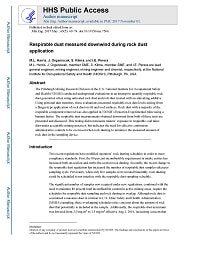Mining Publication: Respirable Dust Measured Downwind During Rock Dust Application
Original creation date: May 2017
Authors: M Harris, J Organiscak, S Klima, I Perera
The Pittsburgh Mining Research Division of the U.S. National Institute for Occupational Safety and Health (NIOSH) conducted underground evaluations in an attempt to quantify respirable rock dust generation when using untreated rock dust and rock dust treated with an anticaking additive. Using personal dust monitors, these evaluations measured respirable rock dust levels arising from a flinger-type application of rock dust on rib and roof surfaces. Rock dust with a majority of the respirable component removed was also applied in NIOSH’s Bruceton Experimental Mine using a bantam duster. The respirable dust measurements obtained downwind from both of these tests are presented and discussed. This testing did not measure miners’ exposure to respirable coal mine dust under acceptable mining practices, but indicates the need for effective continuous administrative controls to be exercised when rock dusting to minimize the measured amount of rock dust in the sampling device.

- Adaptation of Wearable Respirable Dust Monitor Prototypes for use in Underground Coal Mines
- Determining the Spatial Variability of Personal Sampler Inlet Locations
- Dust Considerations When Using Belt Entry Air to Ventilate Work Areas
- Enhanced Utilization of Personal Dust Monitor Feedback
- Equivalency of a Personal Dust Monitor to the Current United States Coal Mine Respirable Dust Sampler
- Laboratory and Field Performance of a Continuously Measuring Personal Respirable Dust Monitor
- Laboratory Evaluation of Pressure Differential-based Respirable Dust Detector Tube
- Laboratory Testing To Quantify Dust Entrainment During Shield Advance
- New Tools To Monitor Personal Exposure To Respirable Coal Mine Dust
- Next Generation Continuous Personal Dust Monitor (CPDM)